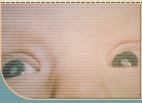
Patching Tips
Entertain and Distract your child. Plan a fun time so that your child will want to stay awake, refrain from removing the patch, and use the weaker eye. Patience, creativity, and commitment will make it happen.
- Someone should be present to play with your child one-on-one. Make a plan with your spouse, friends, and relatives. When your child is older invite his/her friends to come play. This is a perfect time to enjoy your child.
- Introduce a special new toy when you first start patching and allow your child to play with it only when patched.
- If your baby is very young and mobile toys or other toys are not working, carry your child for a 15 minutes walk
- Take note of your child's favorite activities and do these activities during patching time.
- Encourage near vision activities such as coloring, using a workbook, looking at picture books. Other activities include playing video games, picking up Cheerio cereal pieces or other finger foods, playing with blocks.
- When your child is older, patch a stuffed toy at the same time as your child is patched and remove the patch when the child's patch comes off. In time the child can patch the stuffed toy.
- Record points or checks related to patch wearing time on a calendar. Give a reward when a short term goal is reached.
- Decorate the patch or let the older child decorate it.
Establish Time Guidelines. At first you will be the one watching the clock and encouraging yourself to keep the patch on for the prescribed length of time. Later, you will work out a system to let the child know "How much longer?"
- Try not to introduce patching when starting something new such as solid foods, weaning from the breast or bottle, going from the bassinet to the crib.
- Introduce patching when you have more time such as a weekend.
- It is important to achieve the prescribed patch wearing time as soon as possible. However, you may want to increase the length of time the patch is worn by small amounts every day.
- The timing of when you apply the patch will be your decision. You will need to try various times to see what works best for your child at different ages. Some parents have succeeded in placing the patch on the child's eye towards the end of the nap. Other parents report that their child cries when he/she is awakened and sees someone coming at him/her. You will discover what is best.
- When the child is older, you may use a timer so that the child can see the passage of time and knows the patch comes off when the timer goes off. You may also use events of the day as a framework such as "after lunch".
Educate and Praise.
- Educating yourself regarding patching and its purpose is essential.
- If you are having patching problems, talk to your doctor. There are aids such as soft arm splints and gloves which can be used if all else have failed.
- Ask your doctor and study coordinator if they know of any parents who have been through this experience who would be willing to share their experiences with you and help suggest solutions to problems.
- Learn how to make your house safe for your child. Make these changes in your home and protect your little one.
- Educate your child's teacher(s), babysitter, and day-care supervisor.
- Praise your child. A smile, a hug, a resounding "GOOD GIRL! or "GOOD BOY!" will help you both.
- For additional information see the Eye Patch Club write ups called "Tips to Increase Patch Compliance" and "Make Patch Time Count" included in this section.

Patching
#1 - FAQ's
#2 - TIPS
#3 - Practicalities
#4 Video
Glasses
#1 Guidelines
#2 Spectacles
Contact Lenses
#1Contact Lenses
#2Contacts Video
Diary
#1 Eye Care Diary
#2 Detailed Diary Instructions
#3 Diary Video
Tips for Visual Acuity Testing